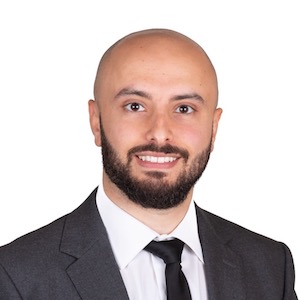
Rekha Manoharan

Wael Isleem

Yu Cheng Chang
 Rekha Manoharan |  Wael Isleem |  Yu Cheng Chang |
Manoharan, Rekha, Isleem, Wael
Faculty / Advisor: Chang, Yu Cheng
University of Pennsylvania School of Dental Medicine, Department of Periodontics
This case report describes Computer-Aided implant planning and placement of implant using the combination of digital technology includes: CBCT scan, Intra-oral scan, and 3D printed surgical guide. The adoption of virtual engineering in dentistry and information digitization can generate a highly predictable surgical outcome.
MethodsCase description – A 56 years old healthy female patient presented to Periodontics Clinic at the University of Pennsylvania for extraction of non-restorable tooth #G and Implant placement. Immediate implant placement and immediate chairside provisional fabrication were completed for better esthetic outcomes and shortened treatment time. Clinical workflow: • Step 1: CBCT scan of the maxilla, intraoral scan (CEREC) of Maxillary and Mandibular arches were acquired to use the STL file for the fabrication of the tooth-supported surgical guide. • Step 2: Both DICOM from CBCT and STL files from the intra-oral scan are implemented in the BlueSky Bio Implant planning software. The surgical guide was designed to have the implant placed based on the restorative treatment plan and available dental socket post-extraction. The Pilot surgical guide was 3-D printed by using Digital light processing technology. • Step 3: Atraumatic tooth extraction of # G was completed, Periotome was utilized to facilitate Periodontal ligament separation and preserve papilla. The surgical guide was placed and complete, accurate seating was confirmed. A pilot drill was utilized to prepare the first osteotomy to correct depth and angulation. Densha burs were used according to manufacturing protocol to osseodensify the osteotomy for implant placement. Astra implant 3.6 X 9mm was placed. Insertion torque >45 NCM was achieved. Xenograft bone particles were packed in the gap between the implant and the buccal plate. • Step 4: The provisional crown was fabricated by using an acrylic shell connected to the temporary cylinder, inserted, and torqued to 15 NCM. Occlusion was adjusted and occlusion interference on the provisional crown was removed.
ResultsResults: 2 weeks follow-up shows uneventful healing and preservation of soft tissue architecture. The final restoration can be fabricated after complete osteointegration of the dental implant.
ConclusionConclusion: The use of digital technology facilitates the planning and execution of implant placement in the esthetic zone for more predictable outcomes based on the restorative treatment plan.